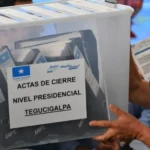
Less than a week after the “operation clamor” began by militants and officials of La Cámpora to nominate Cristina Fernández de Kirchner as president of the national Justicialist Party (PJ)the former president once again publishes a letter that puts her at the center of the political scene. There he states, precisely, that he is running for that position.
The goal? Straighten and order Peronism, which is going through one of its greatest crises of political power and representationafter reaping a broad defeat against the extreme right of Javier Miley.
“Today Peronism only governs 5 of the 23 Argentine provinces and lost the majority in the Senate; This being a situation of unprecedented loss of institutional representation in the democratic period”, he admits CFRP.
“Is it just because of the failure of the last two democratic governments? Or is it that a part of our society is willing to endure anything before a Peronist governs?” Cristina asks. A way of asking if society has become a gorilla.
Without a doubt, the triumph of the Frente de Todos (and the return of Peronism to power in 2019) was in opposition to the disastrous government of Mauricio Macri, who now has to go as the tailgate of the libertarian government and garner his share of power, while It supports the governability of the president who is already beginning to lose popularity due to his attacks on retirees, the income of the majority, students and health.
The triumph of Javier Miley is largely explained by the disastrous government of Alberto Fernández and Sergio Massawhich Cristina integrated, devised and proposed, in which Peronism legalized the macrista debt scamapplied an adjustment program at the service of the IMF and the working people continued to suffer million-dollar looting of their income by the most concentrated capital.
So things are, The “election of thirds”, as Cristina called it, showed a weakness in the political regime as a whole. “Milei’s ‘post-pandemic’ third, plus the diminished third of anti-Peronism, tipped the balance of the runoff against our political strength, even at the cost of electing a president like the one we have,” he explains in this letter. The defeat, however, was by 11 points. Very hard.
Towards the end of the published text, Cristina summarizes her proposal. “It is clear that we must straighten what is crooked and order what is disordered.. This raises the need to create a space for discussion and participation that does not exist today and its absence only generates confusion and emptiness. I have no doubt that, at this stage, The party is the most appropriate place to develop the continent that generates the content and that also has direction and objectives.“Now it is clearer that his political commitment is towards the PJ. By insisting on the need to unite all of Peronism, he once again winks at its right-wing sectors: it is a path that in the last 9 years led to Daniel Scioli, Alberto Fernández and Sergio Massa as presidential candidates, with results in sight.
Peronist party of order, is accompanied by a turn to the right. “We must accept that nothing is set in stone and that everything must be rethought and discussed,” says the former vice president. Also remember that “in the document of September 6 we pointed out some issues: modification of labor relations and its impact, new statehood for a new State, reversal of the fiscal deficit and how to do it, review and public education reformsecurity, modifications in social communication, etc.
In this way, CFK gives in to a large part of the agenda that the extreme right came to impose.
The Peronist union bureaucracy, at the head of the CGT, has already negotiated the labor reform of Javier Milei and the reform of the State. Is Cristina coming to order this in a political program?
The different wings of Peronism were also heard saying again and again, now that Milei is president, that an adjustment was necessary to order the fiscal accounts. And for many, the passive attitude of Peronism in the face of these attacks is interpreted as letting someone else do the dirty work, and then returning in 2027 to manage the ruins of what remains.
Finally, in her postscript, Cristina Kirchner’s letter makes a nod of reconciliation to the large employers’ associations in the countryside.
So, order for what? For a reform of education, a reform of the State? Order to apply once again the failed recipes demanded by the International Monetary Fund?
The egg of the neoliberal snake
“We were never able to agree on what the economic accumulation model should be.“, leaves said CFRP in the postscript of his letter. But apparently, in the ’90s something like this happened in the Argentine political regime, as she herself relates, in the form of a neoliberal model; which, as a project of world capitalism, sought to impose itself throughout the globe.
Was It was the Menemist version of Peronism that inoculated the neoliberal accumulation model in Argentina.which generated unemployment and structural poverty, in addition to generating the outbreak of 2001.
Y The most profound transformations left by that decade were not reversed by the Kirchnerist governments.. To this day, the following persist: privatized public service companies; precariousness and destruction of labor rights, both in the public and state sectors, with flexibility, monotax, labor outsourcing, etc. The federal decentralization of the educational and health system without the corresponding financing, among others.
Now, when these already precarious rights are once again attacked by an attempt at a farcical imitation of Menemism, CFK proposes reviewing them again.
On the other hand, economic growth in the Kirchner era was based on the devaluation and “dirty work” previously done by Eduardo Duhalde and also had to do with the fact that It was a very profitable decade for the trade of commodities . In those years of prosperity, Kirchnerism never reversed the pillars of the neoliberal and dependent structure of Argentine capitalism, which is why the crisis was felt strongly again years later, while in the field of struggles, its policy was to co-opt movements, in their role of diverting and passivizing the social forces that were released with the outbreak of 2001.
Today Cristina confesses that she is pleasantly surprised because the Menemist Roque Fernández affirms that the main problem of the Argentine economy is the debt (and not the deficit as an isolated phenomenon). But she does not even remotely admit that it was once again a Peronist government, which she joined as vice president, that legalized the Macri debt scam and thus once again legitimized the country’s chain of submission to the Yankee IMF.
Organized community, class conciliation
When CFK gives the first design of the Menemist government as an example of a “patched organized community”: an alliance between a business group in the country and the union bureaucracy, together with a member of the national academy… in addition to perhaps indirectly justifying , the integration of the Kirchner couple into the Menem government, also exposes the limit of the Peronist strategy: class conciliation.
That utopia of getting the capitalist class to approach its multimillion-dollar businesses with an awareness of “social justice” was never realized. History has shown globally that even though there are moments where it seems that there is a certain harmony between the interests of businessmen and the people, The capitalist class always attacks the working class.
The national and foreign business community showed themselves to be frank and declared enemies of the working people, even going so far as to commit genocide in our country. That “tragedy of the civil-military dictatorship” that CFK mentions, turned to the extermination of an entire generation of workers and popular fighters, Peronists yes, but also left-wing. And the counterrevolution fell, above all, in the sectors that bravely organized themselves from the bases, outside the discipline of the Peronist union bureaucracies. The last great battle of that generation was against the social pact of Isabel Perón’s government, while they also faced the triple A murderers.
What both Kirchnerism and Peronism seek to avoid by all means is that the force of creative struggle of the working people is unleashed again, as happened in the ’70s, and also in the ’90s and 2001..
Even today, they seek to divide and passivize, through union leaders and the political preaching of Peronist leaders. When, as CFK itself states, the government “is advancing with axes on retirees, universities and even mental health hospitals.” When, as she herself states, we are facing “a kind of strange and dangerous ‘leadership’ of chaos and destruction from which nothing good can come of all Argentines.”
The role of the CGT at this point is one of open betrayal. The whole of Peronism, beyond its nuances, works with one perspective: let Milei fail by devastating the country to return in the elections.
Perhaps that is why, in this new turn to the right, CFK now decides to vindicate, in its postscript, the founding fathers of the North American Revolution. These leaders questioned the Great French Revolution because to end the Ancien Regime it relied on the forces unleashed from below, on the plebeian people, peasants and proto-proletarians of the city, who were the ones who overthrew in a few months, institutions that had taken time. centuries to be erected and founded.
If the turn is towards a PC who stands up as a party to order; The working class and popular bases also have to be very well regimented. That is another of the things that Cristina’s letter implies. He confirms it by saying that “there is no one left over here.” A way to summon all Peronism, even the one that has been giving governance to Milei.
Source: www.laizquierdadiario.com

